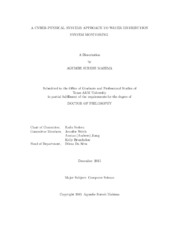| dc.description.abstract | Water Distribution Systems (WDS) are critical infrastructures of national importance that supply water of desired quality and quantity to consumers. They are prone to damages and attacks such as leaks, breaks, and chemical contamination. Monitoring of WDS for prompt response to such events is of paramount importance. WDS monitoring has been typically performed using static sensors that are strategically placed. These solutions are costly and imprecise. Recently mobile sensors for WDS monitoring has attracted research interest to overcome the shortcomings of static sensors. However, most existing solutions are unrealistic, or disrupt the normal functioning of a WDS. They are also designed to be deployed on-demand, i.e., when the utility manager receives complaints or suspects the presence of a threat.
We propose to solve the problem of WDS monitoring through a Cyber-Physical system (CPS) approach. We envision a Cyber-Physical Water Distribution System (CPWDS) with mobile sensors that are deployed in the CPWDS and move with the flow of water in pipes; mobile sensors communicate with static beacons placed outside the pipes and report sensed data; the flows in the pipes are controlled to ensure that the sensors continuously cover the main pipes of the WDS. We propose algorithms to efficiently monitor the WDS with limited number of devices, protocols to efficiently communicate among the devices, and mechanisms to control the flows in the WDS such that consumer demands are met while sensors continuously move around. We evaluate our algorithms, protocols, and design of communication, computation and control components of the CPWDS through a simulator developed specifically to model the movement of sensors through the pipes of the WDS. Our simulations indicate that investing on improving the sensing range of mobile sensors reduces the cost of monitoring significantly. Additionally, the placement of beacons, and the communication range impact the accuracy of localization and estimation of sensor locations. Our flow control system is observed to converge and improve the coverage over time. | en |


